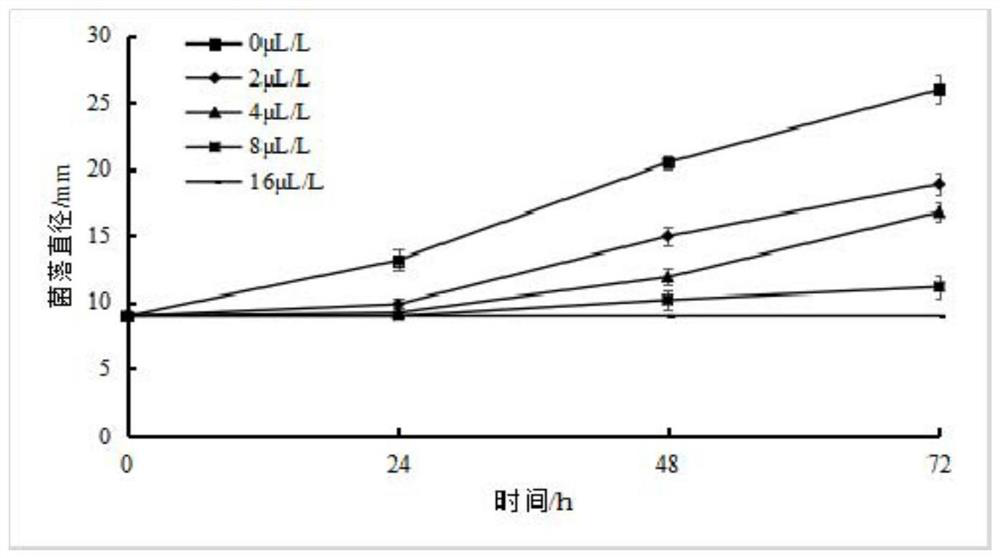Biological control method for fruit and vegetable penicilliosis pathogens
A control method and technology for pathogenic bacteria, which are applied in the fields of chemicals for biological control, botanical equipment and methods, biocides, etc., and can solve problems such as drug-resistant strains, pesticide residues, and environmental pollution.
- Summary
- Abstract
- Description
- Claims
- Application Information
AI Technical Summary
Problems solved by technology
Method used
Image
Examples
Embodiment 1
[0022] Example 1: Example of a spore germination assay
[0023] Spread the sterilized medium on a glass slide and spread 20 μL evenly at a concentration of 1×10 6 cfu / mL Penicillium italiensis spore suspension. Place a piece of sterilized circular filter paper with a diameter of 20 mm in the center of the Petri dish cover, and use a pipette to pipette heptanal onto the filter paper, so that the final concentrations are 0, 5, 7.5, 10, 12.5, 15 μL / L, respectively. Heptanal was not added as a control group. After rapidly sealing the petri dish and culturing in a 25°C incubator for 10 hours, the spore germination was observed under a microscope, and the inhibition rate of spore germination was measured and calculated. Each treatment was repeated 3 times, 3-4 fields of view were counted for each repetition, and each field had about 30-40 spores, that is, at least 100 spores were counted for each repetition.
[0024] The results showed that different concentrations of heptanal co...
Embodiment 2
[0025] Example 2: Mycelial Growth Assay Example
[0026] (1) Inoculate 200 μL of spore suspension on 20 mL of medium, spread evenly on the applicator, invert at 26°C for about 36 hours until white young mycelium is evenly visible, prepare a fungus cake with a 9mm diameter hole punch, and place the fungus cake Put it in the center of the new medium, cover the petri dish with sterile filter paper and add heptanal dropwise, and quickly seal it with a parafilm, so that the concentration of heptanal in the plate is 0, 2, 4, 8, 16 μL / L, with no Heptanal was added as a control group. The plate was cultured at 25°C, and the colony diameter of Penicillium italica was measured by the cross method after 0, 24, 48, and 72 h.
[0027] (2) 200 μL of spore suspension was inoculated into 50 mL of liquid medium, cultured at 26±2°C, 120 r / min shaker for 36 h to obtain young mycelium, and collected by sterile filtration, accurately weighed 0.5 g of wet weight mycelium and inoculated into the me...
Embodiment 3
[0029] Example 3: Measurement Example of Cell Membrane External Conductivity
[0030] Spread a layer of sterilized cellophane on the cooled and solidified 20mL PDA medium, then inoculate 200μL of spore suspension, spread evenly on the applicator, invert at 26°C for about 18h until the white young mycelium is evenly visible, and then add 0, 8, and 16 μL / L of heptaldehyde were fumigated, and the treated mycelia were obtained by inverting culture at 26° C. for 6 h for later use. Weigh 0.5 g of mycelium in a 50 mL clean centrifuge tube, resuspend in 20 mL of double-distilled water, take the mycelial solution without heptaldehyde fumigation as the control group, and measure the conductivity of the solution at 4 h with a conductivity meter.
[0031] Depend on Figure 4 It can be seen that the conductivity of the solution outside the membrane of Penicillium italy increased with the increase of the fumigation concentration under the condition of heptanal fumigation. The L treatment ...
PUM
 Login to View More
Login to View More Abstract
Description
Claims
Application Information
 Login to View More
Login to View More - R&D
- Intellectual Property
- Life Sciences
- Materials
- Tech Scout
- Unparalleled Data Quality
- Higher Quality Content
- 60% Fewer Hallucinations
Browse by: Latest US Patents, China's latest patents, Technical Efficacy Thesaurus, Application Domain, Technology Topic, Popular Technical Reports.
© 2025 PatSnap. All rights reserved.Legal|Privacy policy|Modern Slavery Act Transparency Statement|Sitemap|About US| Contact US: help@patsnap.com



